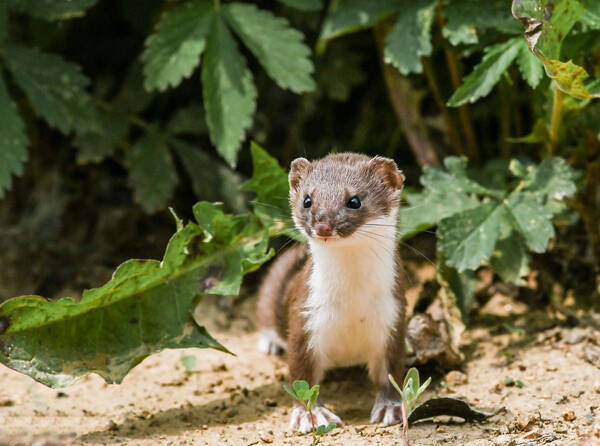Mustela nivalis
IUCN
LCBasic Information
Scientific classification
- name:Mustela nivalis
- Scientific Name:Mustela nivalis,Least Weasel,Silver mouse, white mouse, Japanese weasel
- Outline:Carnivora
- Family:mustelidae mustelae genus
Vital signs
- length:14-21cm
- Weight:50-130g
- lifetime:About 10 years
Feature
The back is brown or coffee-colored in summer and the belly is white, while the coat is white in winter.
Distribution and Habitat
Distributed in Afghanistan, Albania, Algeria, Andorra, Armenia, Austria, Azerbaijan, Belarus, Belgium, Bosnia and Herzegovina, Bulgaria, Canada, China, Croatia, Czech Republic, Denmark, Estonia, Finland, France, Georgia, Germany, Greece, Hungary, Islamic Republic of Iran, Iraq, Israel, Italy, Japan, Kazakhstan, North Korea, South Korea, Kyrgyzstan, Latvia, Lebanon, Liechtenstein, Lithuania, Luxembourg, Macedonia, Malta, Moldova, Monaco, Mongolia, Montenegro, Morocco, Netherlands, Norway, Poland, Portugal, Romania, Russia, San Marino, Serbia, Slovakia, Slovenia, Spain, Sweden, Switzerland, Syria, Arab Republic, Tajikistan, Turkmenistan, Turkey, Ukraine, United Kingdom, United States, Uzbekistan, Vietnam.
China is distributed in Hebei, Heilongjiang, Jilin, Liaoning, Inner Mongolia, Sichuan, Xinjiang and other places.
The habitat of the weasel is somewhat similar to that of the stoat, but it prefers drier areas. In forest areas, it inhabits mixed coniferous and broad-leaved forests,
Appearance
The Ling Weasel has a slender body, short limbs, and small ears. The coat is short, dense, and plantigrade. The soles of the feet are covered with short hair, and the toes and palm pads are hidden in the hair. The feet have five toes, and the claws are slightly curved, slender, and very sharp. There are several long white hairs on the wrists of the forelimbs. The female has 2 pairs of nipples under the armpits and 3 pairs on the mole.
The winter and summer coats of Ling Weasel have different colors. In summer, the back is brown or brown from the upper lip back through the side of the body to the tail end and the outside of the limbs. The ventral surface is white from the throat, neck side to the abdomen. The dividing line between the back and abdomen is obvious and neat. There are white hairs on the instep. The brown or white hairs on the body are the same color from base to tip. The coat is white in winter. A few individuals have brown hairs on their tails.
The skull of the ling
Details
Least Weasel (scientific name: Mustela nivalis) is also known as Least Weasel in foreign language. There are 7 subspecies.

Least Weasel usually moves alone. They often go out to forage during the day. Their hunting areas are generally fixed. Unless food is extremely scarce, they will not leave their living area. They often occupy the nests of small rodents as their dens, and also use fallen trees, caves, grass and earth holes as hiding places. They are fast and agile. They have very sensitive vision, hearing and smell.
The weasel molts twice a year, in spring from April to August, and in autumn from late October to early November. In spring, the weasel molts, starting from the head, then gradually to the center of the back and the sides of the body, and finally to the limbs.
The weasel's food is mainly small rodents. The weasel can enter the activity area of the smallest mice to approach the prey, which is something that the stoat cannot do. The weasel can eat 3,500 small mice in a year, and also eats small birds, frogs and insects. The natural enemies of the weasel are carnivores such as weasels and foxes and birds of prey.
The weasel usually mates in early spring, with a gestation period of about 35 days (Lukashkin believes that mating begins in March and the gestation period is 54 days). Each litter has 3-7 pups, up to 12 pups. Pregnancy occurs once or twice a year. The pups open their eyes at 21-25 days old, and the nursing period is about 50 days. They reach sexual maturity at 4 months old. A weasel can live for about ten years.
The population is not scattered. The population of this species has declined slightly in some parts of Europe, such as the United Kingdom. Although the weasel is widely distributed, it is relatively rare in North America; it is more common in Eurasia, but it is not often found. The population density in suitable habitats can reach 0.2 to 1.0 per hectare, however, in wider areas, the average population density may be as low as 1-7 per 100 hectares. The population of this species fluctuates seasonally every year, but it tends to be stable overall.
Listed in the 2008 Red List of Threatened Species of the World Conservation Union (IUCN) ver 3.1 - Least Concern (LC).
Protect wild animals and eliminate game.
Maintaining ecological balance is everyone's responsibility!








